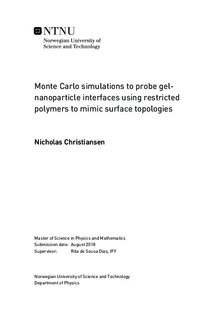Monte Carlo simulations to probe gel-nanoparticle interfaces using restricted polymers to mimic surface topologies
Master thesis
Permanent lenke
http://hdl.handle.net/11250/2569835Utgivelsesdato
2018Metadata
Vis full innførselSamlinger
- Institutt for fysikk [2677]
Sammendrag
The use of silica nanoparticles as an adhesive mediator in hydrogels and suturing of wounds, has been of interest. This thesis investigates the mode of interaction between nanoparticles and a polymer network interface, where the latter is approximated using a simple chain system with varying degrees of restrictions. The idea is that restricting one end should mimic a loose chain on the surface of a gel, while restricting two ends is similar to that of an internalized polymer. The strength of the attractive potential is varied throughout the work.
As would be expected, chains with a fixed end (one node system) show similar interactions with a nanoparticle when compared to free chains. Chains that have both ends restricted and loose or restricted middle monomers (two and three node systems, respectively) show a similar behavior to that of the 1 node systems in the presence of a NP, for short node separations. With increasing node separation, mimicking the swelling of a hydrogel, the two and three node systems show lower sensitivity, in regards to the number of and length of tails, trains and loops, to increasing potentials.
For the three node system there is a clear preference for the nanoparticle to adsorb to the central node for node separations smaller than the range of the interacting potential of the nanoparticles. As the node separations increase, the three node system is similar to that of the two node system, with the nanoparticles preferring to adsorb to the center of the polymer chains.
